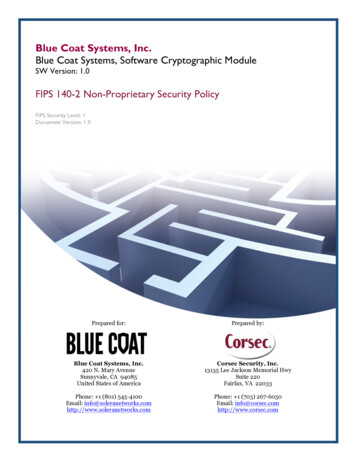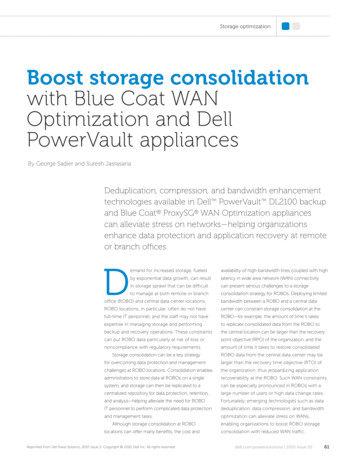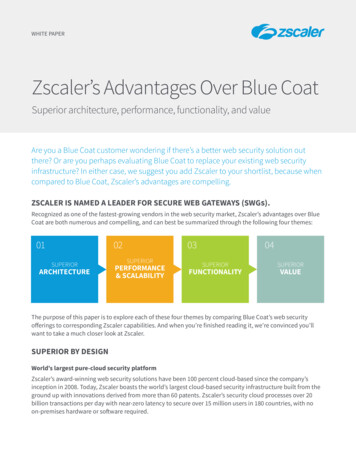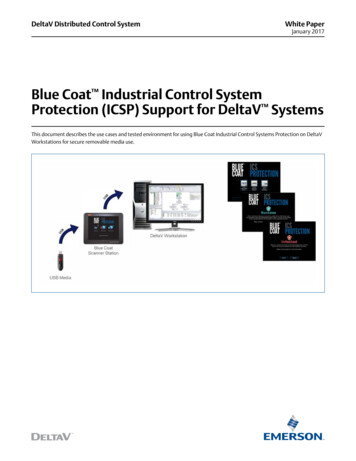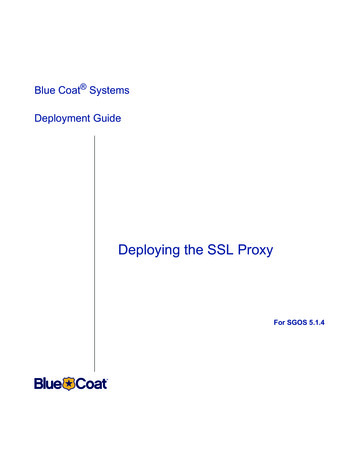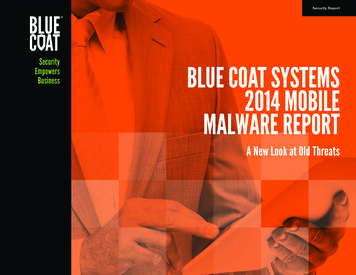
Transcription
Security ReportSecurityEmpowersBusinessBLUE COAT SYSTEMS2014 MOBILEMALWARE REPORTA New Look at Old Threats
2014 Mobile Malware ReportMOBILE DEVICESSTILL REMAINLARGELY FREEOF DRIVE-BYDOWNLOADSMobile Malware: A New Look at Old ThreatsIt’s ironic that mobile devices have fundamentally changedhow we work, live and play, yet the tricks used bycybercriminals to install malware or applications with shadybehavior are the same ones that have been used for years.It’s true that if it isn’t broken, don’t fix it.Despite a significant increase in the number of mobiledevices in use, mobile threats are still defined by the typesof socially engineered attacks that simply trick the consumerinto accepting what the cybercriminal is selling. The BlueCoat Security Lab has yet to see the types of malware thatfundamentally break the security model of the phone.The most prolific mobile threats are spam, poisoned linkson social networking sites and rogue apps. The socialengineering nature of these threats means that user behavioris key in both identifying where attacks might occur (socialnetworking sites, for example) and understanding howattacks may evolve.Likewise, the various mobile malware Trojans which arecapable of data theft are able to operate over either themobile phone network or any connected Wi-Fi network.When these applications transmit their information overmobile phone networks, they present a large information gapthat is difficult to overcome in a corporate environment.2
2014 Mobile Malware ReportLack of Underground Economy Impacts Mobile MalwareIt’s hard to argue that the market for mobile computing is overtaking the traditional PCmarket, which includes both desktops and laptops. According to the research serviceBI Intelligence, at the end of 2013, six percent of the global population owned a tabletand 22 percent owned smartphones. That compares to 20 percent who own PCs.Given the proliferation of the devices and the roughly 1.5 billion new ways to steal data,passwords or money, it is, perhaps, surprising that the mobile malware problem isn’tmore widespread. In part, this relative safety from the mass market malware maelstromthat PC users face results from the lack of a cohesive underground economy.Over the last several years, mass market malware has developed into a robust,highly functioning, if highly illegal economy. Cybercriminals can purchase exploit kitsand even new vulnerabilities on the open (black) market. They can rent botnets, sellthe data they steal and are even protected by service-level agreements. Like othermarket-based economies, the mass market malware economy is subject to the lawsof supply and demand. For example, when the Blackhole exploit kit was taken downlast year, the price for the Magnitude exploit kit skyrocketed.In the mobile world, there is nothing resembling the same type of well-developedexploit kit economy. That means there are no readily available exploit kits where thevulnerabilities have been commoditized and made easier to use as there is in theWindows world. As a result, mobile devices still remain largely free of the drive-bydownloads that surreptitiously install malware without the consumer ever knowing.Stages of a Mobile AttackThe types of mobile attacks that are common are ones that require users to takeaction – to change their security settings, download an app or otherwise give controlof their device to a third-party. This type of social engineering remains the primaryway cybercriminals shape user behavior to make unsafe decisions that compromisetheir device.Blue Coat does not see a widespread use of exploit kits or methods which do notrequire user interaction to infect Android devices with malicious APKs. Users aretypically prompted heavily, using social engineering techniques, to disable the “trustedmarket sources” restriction setting within Android that limits the platform’s ability toinstall arbitrary applications from sources other than Google’s own market.We do see a number of malicious apps originating with porn websites that have amobile component. Many of these sites have a link that allows users to download theapp, which in some cases contain malicious SMSbot components buried among thecode running the declared APK functions.We’ve also seen growth in the number of rogue Android antivirus “products” toutedthrough advertising networks or the use of scripting on mobile websites to promotethem via popup windows in the mobile browser. The threat relies on the user’s owngullibility to follow fairly complex instructions and make changes to the security profileof their mobile devices that are detrimental to their device.A tried and true method that has been the bread and butter of mass market malwareattacks for years, such as fake anti-virus scams, these types of scams are now beingsuccessfully adapted to mobile devices. In a recent attack tracked by the Blue CoatSecurity Lab, a mobile advertisement was the first step in a four-stage (Figure 1)socially-engineered attack: Stage 1: Mobile advertisement from legitimate-sounding security.alert.us tellsconsumer they have a virus and directs them to click the “OK” button to remove Stage 2: An Android warning then pops up and prompts the user to remove thevirus Stage 3: This is the classic social engineered fake anti-virus scan used to targetdesktop and laptop users for years, in which a “scan” is performed and returnsinformation about the purported virus, including details about its malicious behavior– in this case stealing passwords and credit card information. It prompts the user toInstall App Now. Stage 4: Once the file is downloaded, the window prompts the user to change the3rd party app installations in Setting – the feature that prevents app downloadsfrom sites other than the Google Play market that may host shady or malicious appsthat haven’t been vetted.3
2014 Mobile Malware ReportONE IN EVERY FIVETIMES A USERIS DIRECTED TOMOBILE MALWARE,IT IS THROUGHWEB ADS1243Figure 1: Mobile advertisement warns about the virusUser Behavior Drives Mobile ThreatsUnderstanding how users behave on their mobile devices, then, becomes critical forunderstanding where they might be at risk.When we look at consumer behavior on PCs versus behavior on mobile devices, a fewkey distinctions are stark. First and foremost, social networking continues to decreaseas an activity that consumer’s engage in on their desktop or laptop computers.Instead, that activity has shifted to mobile devices.4
2014 Mobile Malware ReportThis is representative of the mobile deviceas part of a consumer’s lifestyle. Withinthe top 15 categories of most requestedcontent, recreation categories (shopping,entertainment, sports/recreation)account for 11.74 percent of all contentrequested by mobile users. For desktopusers, recreational content (shopping,entertainment, games) is just 6.69 percent(Figure 2).Retailers should pay close attention to thisshift in recreational behavior, especiallywhen it comes to shopping. Shopping onmobile devices is the fifth most popularactivity, representing more than sevenpercent of the all mobile activity. Asretailers look at next-generation customerexperiences – experiences that are moresocial, local and mobile, this activity willonly increase.TOP 5 REQUEST CATEGORIESDesktop vs. Mobile Device UsersSearch 5%Web Ads/Analytics—9.62%8.47%8.42%Mixed Content/Adult—Social Networking—Other—42.08%14.91%—Search Engines/Portals14.65% —Content Servers12.75% —Social Networking11.51%7.48%—Web Ads/Analytics—Shopping38.70% —OtherThis is a particularly worrying trend as itcoincides with a significant increase inmalvertising.While mobile users are not yet subject to thesame drive-by downloads that PC users face,mobile ads are increasingly being used aspart of many socially engineering attacks (asseen in our example above). The increasedfrequency of mobile ads conditions users tosee them as normal, which makes users morevulnerable to the attacks that are launchedthrough ads.One of the clearest differences the behaviorsof PC and mobile users also shows why thismatters: For PC users, viewing audio/videoclips represents more than 7 percent of allInternet activity. For mobile users, that numberis just over one percent. It’s not that mobileusers aren’t watching video clips, it’s that theyare doing it through branded video apps likeYouTube and Hulu.Mobile devices open the door for manynew opportunities as well, such asAs a result of this preference for video viewingtargeted coupons while consumers are inthe fake video codec attacks that were verythe store and click and mortar experiencesDesktop/Laptop UsersMobile Userscommon on PCs five years ago are notthat unify online and in-store presence. Allsomething the Blue Coat Security Lab seesof these will continue to drive shopping asFigure 2: Comparing requests between computer and mobile device userstransferring to mobile devices.a category and potentially make it a targetfor cybercriminals that are looking for popular watering holes to target unsuspectingconsumers.Avoid clicking on ads on your mobile deviceIncreasingly, mobile users are being subjected to more ads – even more so than PCusers – as sites everywhere continue to refine their mobile advertisement strategies.Best Practice5
2014 Mobile Malware ReportTHE LACK OFTRANSPARENCYINTO AN APP’SBEHAVIOR SETSUSERS UP TO FAILBY PUTTING THEMAT GREATER RISKFOR PRIVACYVIOLATIONSMalvertising Overtakes Porn as Leading Threat VectorOften times the Internet is a much different place on the mobile device. Smallerscreens and more difficult text entry methods have changed how we access andview online content. So it’s not surprising that it also changes how we are exposed tomalicious content.For desktop users, search engine poisoning and email links are by far the mostprevalent vectors that drive users to threats or malicious content. When we look atmobile users, however, we see a much different picture. Search engines barely crackthe top 10 – sending unsuspecting users to malware only 3.13 percent of the time.Web ads, on the other hand, have outperformed even pornography. In February 2014,web ads represented the single biggest threat vector for mobile users – one in everyfive times a user is directed to mobile malware, it is through web ads. That is almosttriple the rate in November 2012.TOP THREAT VECTORSMobile Environment Shifts BehaviorPornography - 22.16%—Suspicious - 14.09%——19.69% - Web Ads/Analytics—16.68% - SuspiciousComputers/Internet - 7.26%—Web Advertisements - 5.69%—Entertainment - 4.99%—Unrated - 4.30%—Search Engines/Portals - 3.69%—Other - 37.82%—November 20126—16.55% - Pornography—4.19% - Mixed Content/Potentially Adult—4.10% - Uncategorized—3.79% - Audio/Video Clips—3.43% - Entertainment—31.57% - OtherFebruary 2014Figure 3: Shift in behavior for mobile users
2014 Mobile Malware ReportThe rise of malvertising – web ads delivered through legitimate ad networks that directusers to malicious sites or contain malicious code – as a leading attack vector mimicsthe rise of web ad traffic on mobile devices. This is a largely unregulated network ofad servers that can easily be tricked into serving malicious ads unknowingly.What a difference a year makes. Last year, when Blue Coat Security Labs looked atthe mobile malware landscape, pornography was the leading threat vector for mobileusers. This year, it has dropped nearly six points and is the third leading threat vector,responsible to driving users to malware 16 percent of the time (Figure 3).However, pornography remains the most dangerous category of content for mobileusers. With web ads, the rise as a threat vector correlated with a rise in web adrequests. The story is different for pornography. Requests for pornography on mobiledevices don’t even reach one percent of all requested content, yet it accounts formore than 16 percent of all attacks. While users don’t access pornography thatfrequently, when they do, they are very vulnerable to malware.Best Practices Avoid pornography on your mobile devices Consider blocking web ads as a category of contentMobile Malnets: Trial and ErrorThe Blue Coat Security Lab has yet to see any real commitment to mobile malwareamong the top malnets it is tracking. Shnakule, which consistently ranks as theworld’s largest malnet, dabbles in mobileMalnets are themalware, with a preference for premium SMSinfrastructures used to drivetexting scams. Much smaller malnets (too smallusers to malware through ato even be named) pop up from time to time. Itseries of relay and exploitcould be that the behavior we are seeing amongservers. The components aremalnets is an attempt to find vulnerabilitiesreused in multiple attacks,and adapt the infrastructures to these mobileallowing cybercriminals toenvironments.quickly launch new attacks.Application Overshare:Potentially Unwanted Applications and the Threat to PrivacyThe malware threats targeting mobile devices are still pretty basic – largely confined topotentially unwanted applications and premium SMS scams.Potentially unwanted applications, or PUAs, are simply apps, usually disguised assomething interesting like the hottest mobile game, that engage in tracking userbehavior or otherwise sharing personal information.Among the type of data that is tracked are User-Agent strings, which identify themobile operating system, its version, the type of installed browser and version,and (depending on the app) additional information about the mobile app the useris running. In addition, HTTP traffic generated by the mobile device’s browser or bymobile advertising services may reveal the mobile device user’s habits, interests, orsearches.Many apps also include embedded analytics tools used to identify bugs or simplyreport on app usage. These tools can disclose the mobile device’s telephone number,the SIM card’s unique IMEI code, and may reveal the relationships between thedevice’s owner and frequent contacts in the address book.Analytics tools embedded in apps are also capable, depending on how the developerhas configured them, of revealing virtually all aspects of the user’s behavior withinthe app, from key stroke, to “shared” high scores with friends over social media or ononline leaderboards.The majority of this activity is not transparent to the user and potentially exposes theirdata to interception. The lack of clear requirements for developers to explicit identifywhat data their apps access, log, store and share, which makes it difficult for users tomake risk-based decisions about how they use.The lack of transparency into an app’s behavior sets users up to fail by putting themat greater risk for privacy violations. It also makes it impossible for users to makerisk-based decisions about the apps they want to use and the information they wantto share.7
2014 Mobile Malware ReportTHE FUNCTIONALITYTHAT ALLOWSSOMEONE TODONATE MONEYTO A CHARITYIS THE SAMESYSTEM BEINGEXPLOITED BYCYBERCRIMINALSWhile many potentially unwanted apps appear in legitimate markets, they are typicallyquick to respond to customer complaints and will remove a known-malicious appfrom the market. In some cases, the market will also remotely uninstall known-badapps from the phones of users who downloaded and installed them.Unfortunately, malicious mobile apps tend to have longer lives in collections ofallegedly-pirated mobile software and in foreign app markets or stores where theoperators of the market less thoroughly (or don’t at all) scrutinize mobile apps beforeallowing people to post them for others to download.Best Practices Never download or purchase an app outside of legitimate markets such as theApp Store or Google Play. Enterprises that have bring your own device or corporate mobility initiativesshould look at pre-approving mobile apps that present a lower risk of dataleakage or privacy violations. Third-party services are in the early stages ofoffering risk profiles on applications to help enterprises assess their exposureand balance the risks of using a particular app against the benefits.Premium SMS Apps: The New 900 Number ScamA significant number of Android apps, in particular, engage in premium SMS scams.These apps surreptitiously sign up users for messaging services that chargethe victim’s mobile phone account a per-use or per-month fee, similar to the old900 number scams that racked up hundreds and thousands of dollars in bills forunsuspecting callers.Premium SMS apps have quickly become the most popular piece of Androidmalware due to the fact that mobile devices have a banking system built into it.The functionality that allows someone to donate money to a charity during a naturaldisaster is the same system being exploited by cybercriminals. Each SMS textmessage of 5 or more to a number owned by the cybercriminal is added to yourmobile bill.8
2014 Mobile Malware ReportThe SMS text messages are often sent without mobile phone users being able todetect it and could run up hundreds of dollars in charges before the users receivestheir mobile phone bill.Most of these malicious apps have some connection with mobile porn sites. Either thesites have links to download a mobile porn app that is really a malicious SMSbot APKor social engineering techniques on a mobile porn site are used to convince a user todownload the malicious app.SummaryBlue Coat predicts that mobile malware will continue to present a threat to usersboth in the corporate and home environment. The makers of mobile phone operatingsystems would do well to help users better manage how, when, and with whommobile applications can communicate with the outside world.As a result of the volume of consumer complaints about premium SMS scamapplications, some mobile phone service providers are actively working to thwartthese scams by giving phone users the ability to block this type of service entirely.9
SecurityEmpowersBusiness 2014 Blue Coat Systems, Inc. All rights reserved. Blue Coat, the Blue Coat logos,ProxySG, PacketShaper, CacheFlow, IntelligenceCenter, CacheEOS, CachePulse,Crossbeam, K9, the K9 logo, DRTR, Mach5, Packetwise, Policycenter, ProxyAV,ProxyClient, SGOS, WebPulse, Solera Networks, the Solera Networks logos, DeepSee,“See Everything. Know Everything.”, “Security Empowers Business”, and BlueTouchare registered trademarks or trademarks of Blue Coat Systems, Inc. or its affiliates inthe U.S. and certain other countries. This list may not be complete, and the absenceof a trademark from this list does not mean it is not a trademark of Blue Coat or thatBlue Coat has stopped using the trademark. All other trademarks mentioned in thisdocument owned by third parties are the property of their respective owners. Thisdocument is for informational purposes only. Blue Coat makes no warranties, express,implied, or statutory, as to the information in this document. Blue Coat products,technical services, and any other technical data referenced in this document aresubject to U.S. export control and sanctions laws, regulations and requirements, andmay be subject to export or import regulations in other countries. You agree to complystrictly with these laws, regulations and requirements, and acknowledge that youhave the responsibility to obtain any licenses, permits or other approvals that may berequired in order to export, re-export, transfer in country or import after delivery to e Coat Systems Inc.www.bluecoat.comCorporate HeadquartersSunnyvale, CA 1.408.220.2200EMEA HeadquartersHampshire, UK 44.1252.554600APAC HeadquartersSingapore 65.6826.700010
successfully adapted to mobile devices. In a recent attack tracked by the Blue Coat Security Lab, a mobile advertisement was the first step in a four-stage (Figure 1) socially-engineered attack: Stage 1: Mobile advertisement from legitimate-sounding security.alert.us tells
